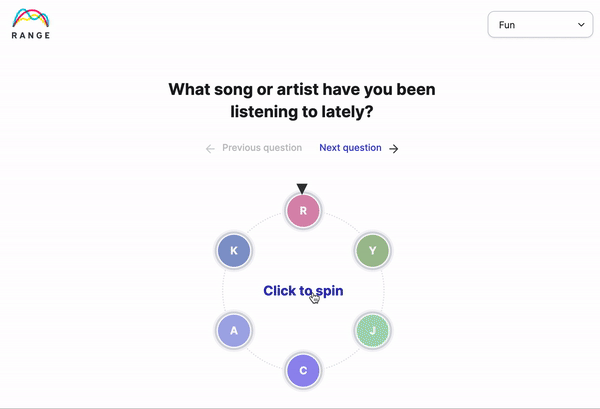
Accountability at work.
Accountability means showing up and setting out to accomplish the things you’d said you’d do. It’s about taking personal responsibility for your work. It’s also trusting in your teammates and knowing you can count on each other to get things done.
Creating a culture of accountability is an essential tool used by high-performing teams to develop better work relationships, eliminate surprises, and improve overall job happiness.
But it’s a lot harder to achieve than you might think.

No sign-up required
Try our (free) icebreaker generator
Take a spin! Start your next meeting with one of these icebreaker questions. It works the same way in Range.
What does accountability at work really look like?
For most teams, building up a shared understanding of accountability is the first step.
What exactly does it mean to be accountable at work and to your teammates?
Webster's Dictionary says the definition of accountability is: "the obligation or willingness to accept responsibility for one's actions."
At work, that might look like owning a mistake and sharing it as a learning experience or giving a presentation around your personal contributions and their impact.
Henry Evans, the author of Winning with Accountability, says accountability is “clear commitments that in the eyes of others have been kept.” Here, the phrase “in the eyes of others” is key. On teams, accountability isn’t just about making and keeping commitments – it’s also about transparency and sharing with teammates along the way.
When we make our commitments visible to our teammates (through daily check-ins and goal-setting), everyone is empowered to ask follow-up questions, check on progress, and help move work forward.
Exercise: Team accountability standards
Come together as a team and discuss what accountability means to you. It can be helpful to write out a shared definition and some examples of how accountability looks in certain common workplace scenarios.
Document your standards and share them with new team members so everyone’s on the same page.
What are the benefits of accountability in the workplace?
Your team’s approach to accountability can have an impact across just about every aspect of work.
Accountability fosters better work relationships, improves job satisfaction, and helps teams work more effectively together.
It empowers ICs with ownership over their work and fuels more effective teamwork, since folks know they can count on each other to get things done.
Mastering team accountability can help teams have better performance discussions and hold each other accountable in a more supportive way, too. It inspires individuals to exceed their goals and improve their performance, and it’s intrinsically linked to results (and revenue).
Employee engagement, according to Gallup, helps companies outperform their competitors, and can result in 21% greater profitability.
Despite these truths, many teams still struggle to build up their employee accountability muscle.
The accountability gap
Is your team routinely plagued with missed deadlines, broken promises, or vague expectations?
Do managers constantly hound folks for updates or feel the need to micromanage?
If those symptoms sound familiar, your team may have an accountability gap.
If your team struggles with a lack of accountability you’re not alone. 25% of managers say an absence of accountability is one of the biggest hurdles for their team.
It’s linked to serious issues like poor performance, low team morale, increased employee turnover, and decreased output.
Without accountability standards and accountability systems in place, folks will constantly struggle to know what’s expected of them and perform to their fullest potential.
Build a daily routine around accountability
Accountability isn’t just something to think about during quarterly reviews or when something goes wrong.
High-performing teams practice accountability every single day.
- Open communication
- Sharing commitments
- Reporting on their progress
One super simple way to do this is through daily or weekly check-ins, where teammates share updates on what they’re working on, what they need from the rest of the team, and how they’re doing.
With Range Check-Ins, you can:
- Reduce meeting load by keeping every team member informed and connected
- Easily share your plan and what you accomplished
- Check-in on a personal level and stay in-the-know – wherever your team is.
- Customize questions, prompts, and icebreakers
- Integrate seamlessly with Slack, Google Docs, Microsoft365, JIRA, Asana, Zoom, and more
- Share updates via Slack or Microsoft Teams
Building systems for accountability into your team’s workflow can help ICs feel more empowered and help managers support them, without micromanagement.
You can have better performance discussions, build healthy habits around planning and goal-setting, and achieve better results. If you want your team to be more effective, invest in team and individual accountability.
4 ways to create more accountability in the workplace
1. Model accountability on your team
When it comes to building a culture of accountability, change starts with you.
Team accountability is impossible without strong personal accountability in place first, so it’s important to first work on yourself before approaching an accountability conversation with co-workers or direct reports.
In Winning with Accountability, Evans suggests writing down two commitments that are important to your success – one for your work and one for your personal life. These should be things you plan to take full personal responsibility for.
Then, share them with your entire team and encourage everyone to hold you accountable. (This exercise is critical whether you're an IC, a manager, or the CEO. Responsible leaders foster responsible teams.)
If you’re in a position of leadership, Evans says you’ll be more effective holding your employees accountable if you’re willing to be held accountable by others yourself. Show your commitment to accountability by taking ownership over the impact of your actions (or inactions) and be open to teammates checking in on the status of your work.

Foster Daily Accountability
Use our Team Accountability check-in template to help your team know what's happening and move work forward, without extra meetings.
2. Set clear expectations for team members
It may sound obvious, but doing what your teammates expect of you requires clarity around what’s expected in the first place.
Let’s say you ask someone on your team to “complete the project according to the highest standards and as soon as possible.” This is problematic for many reasons.
For starters, if you ask five people what “to the highest standards means,” you'll probably get five different answers. For some, it might mean prioritizing detail and precision.
For others, it means completing the work effectively and with agility – speed over perfect. The same problems come up for “as soon as possible” – does it mean in an hour, tomorrow, next week, or sometime this quarter?
Unclear expectations and lack of specificity create accountability gaps. To fill these gaps and reduce ambiguity, try to be as specific as possible.
Strategies for stronger expectation-setting:
- Define project ownership: Work with your team to clearly define who owns what. Many teams like to use a RACI chart for each project — clarifying who should be responsible, accountable, consulted, and informed on the work.
- Use a detailed project spec template: Project specs and one-pagers help teams create alignment, clearly define expectations, and eliminate accountability gaps. Each one should specify the project timeline, ownership, and specifics on the deliverable (if possible, provide examples). It can be helpful to create a project spec template to save time and ensure a standard set of information is included in each.
- Get more intentional with meeting action items: Action items are valuable for a variety of purposes – building accountability is a big one. When action items come up in team meetings, it’s all too easy for them to slip through the cracks or lack enough specificity to drive follow-through. To keep action items top-of-mind, assign a notetaker to document them as you go and share them out immediately after the meeting ends. You can also try our action-item template to inspire even greater accountability.
- Publicize roles and responsibilities: When people know their role, they’re more likely to feel a sense of ownership and take charge of their work. Likewise, when teammates understand each other’s roles, it strengthens collaboration, communication, and trust because they know who to turn to for what and what is (and isn’t) expected. As a manager, make it a point to publicize everyone’s role and revisit expectations on a regular basis.
Leadership tip: Think about how you’ll reward people on your team for the work they do, especially tedious and drawn-out work that’s not as visible.
For more on this tip, watch our Lead Time Chat with Camille Fournier.
3. Create a “safe space” environment
Trust and psychological safety are foundational to building a culture of accountability. Without them, folks on your team won’t feel comfortable opening up, sharing transparently, and taking ownership if things don’t go as planned.
When you build up psychological safety on your team, people feel safer taking risks, asking for feedback, and being vulnerable in front of each other through the ups and downs that inherently come with any job.
Tip: Show that it’s OK to be vulnerable.
For personal accountability to truly work, people need to be transparent and honest about where they're at, and take complete responsibility through the ups and downs of work. To encourage this behavior, start by modeling it yourself. If you’re having a hard day, say so. If you’re distracted by something outside of work, let them know. If an experiment you tried failed miserably, share that too. (Failure should be something folks feel safe talking about — not something they shy away from.)
4. Use the Accountability Puzzle
The Accountability Puzzle is a model that helps teams foster more conversation around l accountability and build up their muscle over time.
The puzzle (created by Henry Evans) consists of four pieces, or accountability requirements, which each reinforce the others. When a single piece is missing, so is accountability.
- Clear expectations: Like we covered above – the ask, task, expectation, or project should be detailed and clear. One tool that can help with assessing specificity and clarity here is the SMART goals framework.
- Specific date and time: Be specific about dates, times, and time zones. Align priorities and resources with your biggest goals.
- Ownership: One task, one owner. Each task owner takes responsibility for seeing it through and accepts responsibility for the outcome.
- Sharing: Accountability is created when two or more people know about a specific commitment. It’s crucial to make your team your accountability partners—it’s about declaring your commitment and asking your teammates to hold you accountable.








